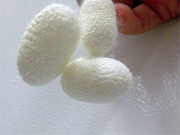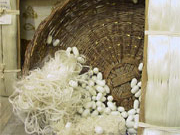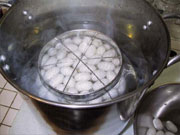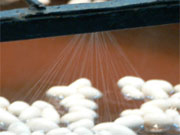Silk exists thanks to the silkworm. The silkworm feeds exclusively on the leaves of the mulberry tree. In the process of transforming into a butterfly, the caterpillar spins a cocoon made of very thin threads and glue that it has secreted itself. As soon as the cocoon is ready, but before the butterfly emerges, the caterpillar - unfortunately unavoidable in this process - is killed.
The "caterpillar-friendly" silk (wild silk or tussah silk) comes from cocoons of wild silkworms that have already fled as butterflies. As the cocoon has hatched, it has been damaged, and the threads can no longer be unwound as a single unit.


Source of silk
The "Bombyx Mori" caterpillar is most commonly used because this species spins a cocoon from an extra-long thread. The total length of the thread can vary from 2500 to 3500 metres. Only the middle wire of about 1000 to 1500 metres (= reel side) can be unwound in one length of the cocoon. From the shorter threads, the remnants, the so-called chap silk (= waste silk) is made.
The process
Before the silk thread can be unwound, the glue substance (sericin) is boiled out of the silk; this process is called "de-bonding". When the glue has melted, the thread can be unwound with special brushes and then used as silk yarn. With wild silk, de-basting is not done; wild silk still contains residual glue.


Properties of silk
The silk thread is the finest of all the natural fibres. Chemically speaking, silk is very similar to wool. Both consist mainly of proteins, but unlike wool, silk fibres are smooth and do not have a scaled structure, which makes them shine. Silk has a large number of pleasant properties and is suitable for many applications. Besides clothing, it is also used for many other purposes, such as bedding, home textiles, filling for quilts, etc.
Benefits of silk, comfort
Silk is both strong and elastic. You can stretch a thread by as much as a fifth of its original length before it breaks. Silk hardly charges statically. Silk can absorb a lot of moisture (up to 40%) without the fabric feeling damp. It also has iso-thermal properties that make it feel cool in hot weather and cosy warm in cold weather. Silk is therefore popular as a basic material for sports and leisure clothing. In addition, silk is not very susceptible to moulds and moths.
Types of silk
Silk fabric exists in a large number of forms, an overview of the most common types:
- Satin silk
- Silk jersey
- Chiffon silk
- Habotai silk
- Silk "Crêpe de Chine"
- Georgette silk
- Jacquard silk
- Bourette silk
- Dupion silk
- Tussah silk / wild silk
- Organic silk
Maintenance of silk
What is the best way to wash silk? You can find more information here.
